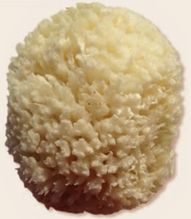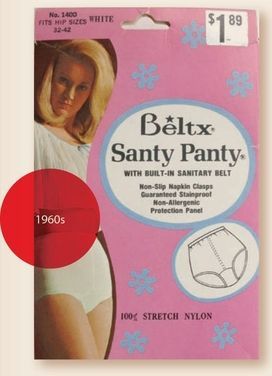Flow: The Cultural Story of Menstruation (32 page)
Read Flow: The Cultural Story of Menstruation Online
Authors: Elissa Stein,Susan Kim
Tags: #Health; Fitness & Dieting, #Women's Health, #General, #History, #Historical Study & Educational Resources, #Politics & Social Sciences, #Women's Studies, #Personal Health, #Social History, #Women in History, #Professional & Technical, #Medical eBooks, #Basic Science, #Physiology

Courtesy of Diva International, Inc

Some women prefer sea sponges to soak up their flow. Sea sponges aren’t plants, but literally sponge-like creatures—just about the lowest form of primitive animal life around—that grow in colonies on the ocean floor. Sea sponges work just like tampons, without applicators or strings for removal. To use, one merely squishes one up and inserts it into the vagina, where it expands as it soaks up blood. To remove, one pulls it out, rinses off the blood, and pops it back .
in. After air drying, it’s ready for the next cycle.

As with the menstrual cup, reusability is a big plus—a sponge can last about six months or so—but some women find that they leak more than tampons. What’s more, bacteria can build up, so one’s sponge needs to be periodically soaked in vinegar and water or peroxide to be kept safe. And not to make one lose one’s appetite or anything, but sponges, natural organisms that they are, have been found to contain sand, bacteria, grit, and other tiny, gnarly substances that one should definitely not be introducing into one’s vagina.

Back in the 1960s, before adhesive strips changed femcare forever, clever manufacturers came up with sanitary panties and “panty-kinis” (a bikini-bottom-inspired style marketed to teens) that held pads in place, rather than the traditional cumbersome, homely belts and pins. Today, some smaller companies have taken that idea one step further and sell all-in-one “period panties,” made with extra padding sewn permanently into the crotch. Some, made specifically for lighter days, are advertised as being a substitute for panty liners or shields. And others are designed to hold extra layers of fabric, also reusable, in the crotch to catch one’s flow. After use, all can be thrown in the laundry.
One can also buy reusable pads that have extra sewn-in layers to soak up blood. Reusable cloth pads are nothing new; after all, women throughout history used them, and in fact, millions still do around the world. The upside? Many women find reusable pads, generally made out of flannel or other soft cotton, to be supercozy and comfortable. They’re available in a variety of fabrics and patterns—crafty women can even make their own, downloading free patterns from the Internet and firing up the Singer. Plus, cloth pads can be used for years and contribute zilch to landfills.
Ecologically speaking, that’s terrific. The downside is that they take work. Using cloth pads for years and years means you have to wash them for years and years. Generally speaking, one first soaks them in cold water and then throws them in with the laundry. Frequently, they also need a good hand scrubbing first to get rid of those stubborn bloodstains. All together, this can mean a lot more effort than some women want to give … and unless one already does a lot of laundry regularly, it can also lead to increased amounts of detergent being dumped into the waterways. As a result, some women find the best compromise is to use cloth pads (or other alternate femcare) only part of the time: at night, or on light days.
There are also alternative ways to deal with cramps and other unpleasant symptoms. Funnily enough, many of the out-there therapies currently in vogue are in fact nothing new, not by a long shot. For instance, herbal remedies for menstrual discomfort have not only been around for thousands of years, they were what all those midwives and village healers used to sling around in their bulging granny sacks. Eons before some guy in a suit came up with the name “Midol,”these women were already pulling out the heavy herbal artillery to treat bloating, cramps, irregular periods, heavy bleeding, headaches, and skin problems, as well as to increase fertility, end pregnancies, and ease symptoms of menopause.

In the spirit of book research and eco-conservation, I delved into the world of reusable pads. There is quite a selection out there, and after much debating, vintage robots and groovy psychedelic flowers were my patterns of choice. They were fun to play with (snap on, snap off, snap on, snap off), and my kids found a variety of uses other than their intended purposes. Unfortunately, August was test month, and when it was ninety-plus degrees, all that flannel between my legs felt remarkably like wearing a hot and sweaty diaper. The total turn-off, though, was after using one. Seeing blood seeping into that pale blue background, covering those robots’ little bodies, was too reminiscent of a lifetime of leaks—I had flashbacks of frantically trying to get rid of stains from my white carpenter pants before they set and ruined them forever. But no matter how much Ivory soap, scrubbing, and soaking, that faint brownish stain (then, and now) never went away. Perhaps it’s been too many years of bleached-white, hygienically sealed, disposable pads. Even though I theoretically wanted to cut down on consumption and not contribute as much nonbiodegradable material to landfills, in the end, I’m sticking with Always. With wings.
—Elissa S. (43)

Black cohosh, for example, is a powerful plant that was used for years by Native Americans. A natural antispasmodic, anti-inflammatory, and natural sedative, it was practically made to fight menstrual discomfort, PMS, and the pain of childbirth. And according to the Mayo Clinic, it’s also an effective treatment for numerous menopause symptoms, such as hot flashes, vaginal dryness, heart palpitations, and emotional swings.
Dong quai is a Chinese herb that’s been effectively used for thousands of years. Best known as a muscle relaxant, it also tones and strengthens the uterus by causing it to contract before relaxing. A strong uterus is apparently a happy uterus; and a happy uterus means fewer menstrual cramps for the lucky female. Dong quai also appears to balance hormonal levels and helps regulate menstrual cycles that are out of whack.
Red raspberry leaf is another age-old star of the herbal hit parade and is said to promote a woman’s health, not unlike dong quai, by strengthening her uterine walls. It’s similarly recommended for relieving cramps and regulating periods. It’s also suggested for use during pregnancy as it can ease nausea, help women relax during labor and delivery, and also get cycles back on trackafter birth.
Motherwort, ginseng, licorice, skullcap, ginger, dandelion, nettle, milk thistle, and pennyroyal … all of these are not only currently recommended to nonpregnant women for uterine health, symptom relief, and menstrual regularity, but were also routinely featured in certain patent medicines or nostrums, those mysterious and suspicious-looking elixirs and potions from the nineteenth century. In those heady days before federal regulations took all the fun out of healing, medicine makers didn’t have to reveal what ingredients they used for their frequently demented claims; sure enough, some of the more dubious nostrums were eventually found to contain copious amounts of opium, cocaine, turpentine, camphor, and even radioactive materials. Yikes! Nevertheless, there were a few brands like Lydia Pinkham’s Vegetable Compound, based on already-existing herbal remedies, that were much more benign and even pretty effective.
One popular patent medicine in the 1880s was manufactured by what would soon become one of the first pharmaceutical giants, Parke, Davis & Co. Called Chi-Ches-Ters, the tiny pill featured the you-catch-our-drift tagline “Chi-Ches-Ters turn ‘problem’ days into party days.” Chi-Ches-Ters, which was on the market until the mid-1950s, contained such ingredients as cotton root bark, hellebore, iron sulfate, and aloe; chances are it originally contained cocaine, as well, but that was before they got all the kinks out. Cotton root bark, a common folk remedy among African slaves, is still used to help regulate menstrual flow. Similarly, cotton root bark and hellebore have also traditionally been used for menstrual disorders, iron sulfate is used to treat anemia, and aloe is a laxative. Altogether not the worst combination for dealing with some of the more annoying symptoms of menstruation!
Manufacturers now market a wide variety of menstrual and reproductive tonics and remedies, featuring several beneficial herbs all rolled into one package. You can even find premenstrual, pregnancy, hormonal-balancing, nursing, or female-toner tea/ herbal combos in a cup. But before hotfooting it to one’s local health food store, we suggest one spend some time reading, researching … and asking plenty of questions. Bestselling authors like Dr. Andrew Weil (Women’s Health: Ask Dr. Weil), Dr. Christiane Northrup (Women’s Bodies, Women’s Wisdom: Creating Physical and Emotional Health and Healing), and Gary Null (For Women Only: Your Guide to Health Empowerment) suggest alternative therapies for all stages of female life, and theirs are just a few reputable voices of dozens, if not hundreds, out there.
There’s encouraging word about vitamins and minerals, as well. The American Journal of Obstetrics & Gynecology notes that calcium and manganese, when taken together, significantly reduce mood swings, loss of concentration, and cramps during menstruation; they also reduce water retention during the premenstrual time. Vitamin E is said to regulate hormone levels and has been shown to significantly relieve breast tenderness and soreness. B-6 is a natural diuretic, which, trust us, comes in handy when menstrual bloat has turned one into an uncanny ringer for the Michelin Man.
And speaking of bloat, don’t forget that something as simple as diet itself can make a huge difference. Cutting down on salt before your period can help you avoid all that unholy swelling. It’s also known that constipation, not surprisingly, can make bad cramps even worse … so add that to the list of reasons one should consider adopting that high-fiber diet, washed down with plenty of water. Those who have discovered juicing also recommend a combination of apple, celery, and fennel juices to relieve menstrual cramps. Pineapple juice is said to relax muscles and help with cramps, as well.
